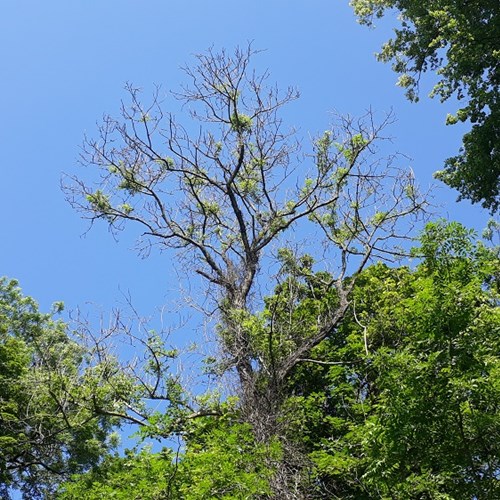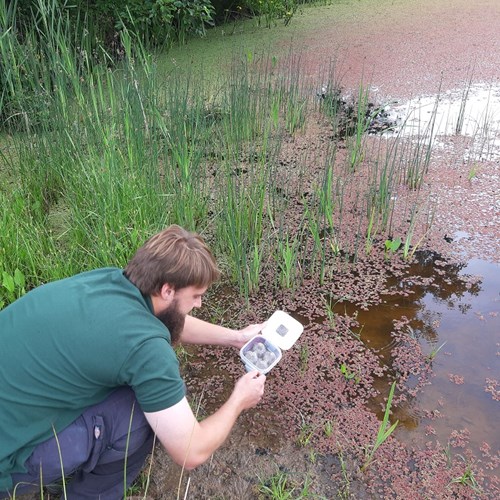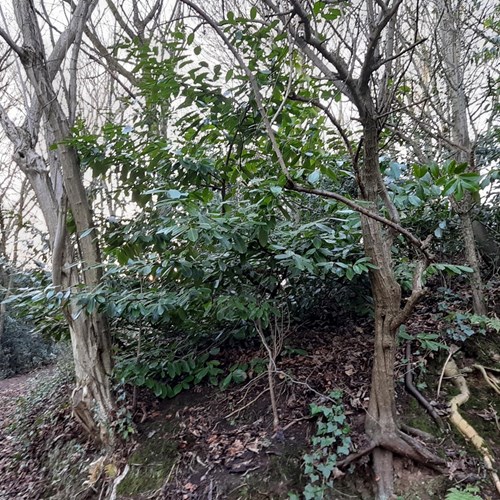Invasive non-native species are one of the top causes of biodiversity loss worldwide. Here on the Malvern Hills and Commons, invasive species are having a huge effect on our nationally important wildlife and a negative impact on people’s health too.
This Invasive Species Week (15th to 21st May) the Malvern Hills Trust is highlighting the species that are having the biggest impact on the local landscape and the increasing efforts required to control and manage the issue. Collectively controlling non-native species costs us over £60,000 every year.
Some of our most damaging invasive non-native species
Cherry Laurel – This large evergreen plant first recorded in the wild (outside of gardens) in 1886 and has continued to spread throughout the countryside, including onto the lower slopes of the Malverns. Due to its dense, year-round foliage, it stops light from reaching the woodland floor, smothering all native plants. The Trust has been working for a number of years to kill laurel across tens of acres to allow native species such as bluebell and wild garlic to once again flourish, and to encourage the natural regeneration of woodland plants.
Himalayan Balsam – As the name suggests, this fast-spreading plant is native to the Himalayan region. It can now be found along the banks of many rivers and streams including on Trust land at Clevelode. The explosive method by which it spreads its seeds means that they can be expelled up to 7metres from the parent plant. Volunteers and staff pull up plants before they seed to try and reduce spread from this small section of the River Severn. Himalayan Balsam ID sheet.
Water Fern – Found in ponds in the Guarlford Road area, this tiny fern forms a dense blanket across the pond surface. By stopping light from reaching the water and covering the surface it causes the deoxygenation of the pond, killing aquatic life. It can be spread from pond to pond by tiny plant fragments on shoes or machinery / equipment or by animals, including dogs. There are no native organisms which feed on the Water Fern however, a weevil native to North America has been purchased and introduced to local ponds by the Trust to control this plant, following CABI guidance. Water Fern ID sheet.
New Zealand Pigmyweed – Native to New Zealand and Australia, this plant was first brought into the country for garden ponds. It is easily spread from pond to pond by tiny plant fragments carried by people, equipment and animals. The Trust has recently carried out an innovative project to eradicate the pigmyweed from ponds on Castlemorton Common by covering them in black plastic for 2 years to restrict light to the pond to kill the invasive plant. This appears to have been successful. New Zealand Pigmyweed ID sheet.
Japanese Knotweed – Small patches of Japanese Knotweed have been found on the hills and commons, likely to have spread from nearby gardens. Each of these sites is regularly monitored and this invasive plant is controlled by a number of expensive methods requiring professional help and safe disposal. It can take many years for the plant to be eradicated as it can re-sprout from small root fragments. Japanese Knotweed ID sheet.
Giant Hogweed – This plant originates from the area near to Azerbaijan and can grow to 2-3 metres in height. When the sap comes into contact with the skin, it can cause painful blisters in sunlight which can persist for a number of years. Eradication for public safety is a priority for the Trust and the plants are carefully removed by staff each year before they seed. Giant Hogweed ID sheet.
Ash dieback disease – This disease threatens the whole of the UK’s ash population and is expected to kill up to 80% of ash trees. The disease is caused by a fungus which originates from Asia and was first identified in the UK in 2012. The death of ash trees along roadsides and near to properties poses a huge safety risk and has impacted the Trust both practically and economically costing around £40k per year. You can make a donation towards the Trust's ash dieback response.
For further information on non-native species please see the Non-native species secretariat.
How you can help
Non-native species can be introduced into the environment intentionally or unintentionally. You can help by:
- Disposing of your garden waste properly to stop unwanted plants from spreading onto the Hills and Commons.
- Not planting anything on Trust land including common plants such as daffodils.
- Avoiding letting your dog into ponds as they can act as carriers for non-native species, spreading invasive species from pond to pond.
- Report sightings of invasive plants on MHT land to our reception 01684 892002.
- Making a donation to the Ash Dieback fund to support the Trust’s work in responding to this devastating disease.
As the number and spread of invasive non-native species increases, the more of the charity’s time is being put towards the, often complex and difficult, control of these species on the Hills and Commons.



